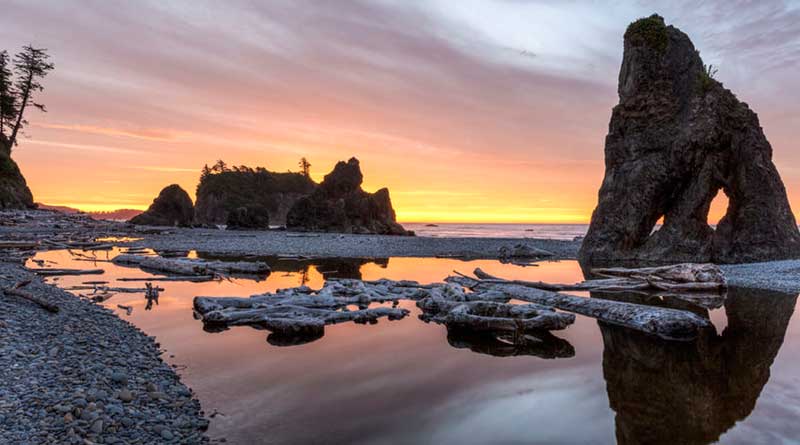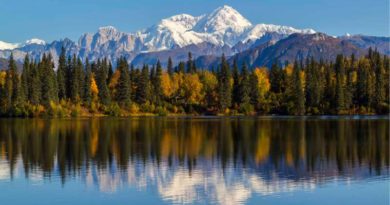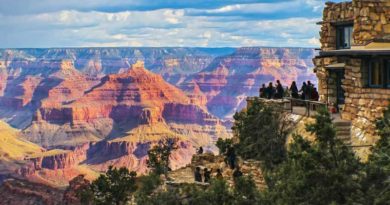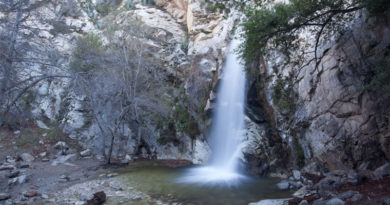The 10 Best Day-Hikes in Olympic National Park
Olympic National Park is located just two and a half hours from Seattle on Washington’s Olympic Peninsula. It offers extraordinary and diverse hiking opportunities. Glaciated mountains, waterfalls, rainforest, and the Pacific coast, it has it all and well-maintained hiking trails are leading to all these destinations.
With nearly a million acres of park to explore and covering four varied and majestic ecological regions, figuring out how to make the most of your visit to Olympic National Park can be difficult for a first-timer.
Visitors flock to Olympic National Park to enjoy a rare rainforest in North America. The Olympic Mountains receive 12 to 14 feet of rain every year yielding lush vegetation. Combine that with snow-capped mountains, 70-miles of coastline, and a dozen pristine rivers, and Olympic National Park becomes a natural treatment for you to explore.
Here are the 10 best day-hikes in Olympic National Park that can help you make the most out of your trip.
1. Hurricane Hill Trail
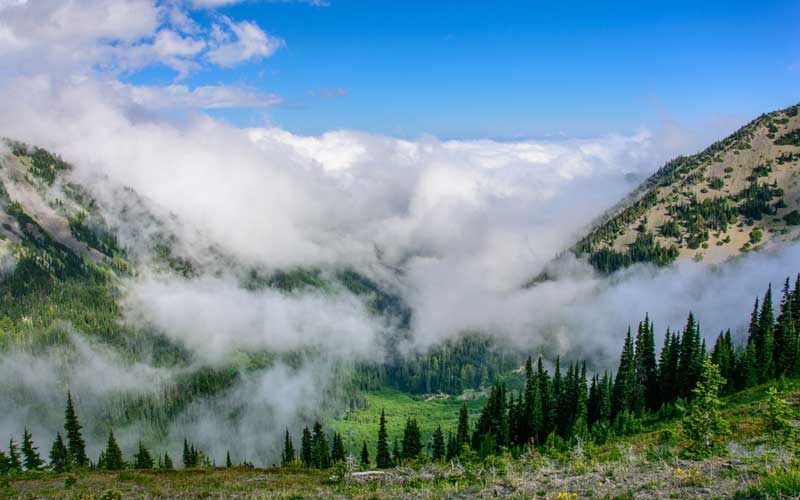
Hurricane Hills provides the best views of the Olympic Mountains, Vancouver Island, and Mount Baker. You can spend hours looking at these wonderful views and enjoy it. Located just past the Hurricane Ridge Visitor Center, this trail is a year-round favorite for tourists and locals alike.
During the summer months, this trail is easy enough for even families to enjoy. You can drive up to the trailhead in the summer making it shorter. In winter, the trailhead is longer due to being covered in snow. Yet it still offers some of the best areas for snowshoeing and cross country skiing.
This hike is an excellent choice if you are structuring a few events for your day, as it can easily be completed in a few hours; likewise, the wide trail and short distance makes the trail ideal for families. During the late summer, marmots, deer, and wildflowers are abundant, with an occasional mountain goat sighting is possible on the nearby ridges.
2. Ozette Triangle Loop
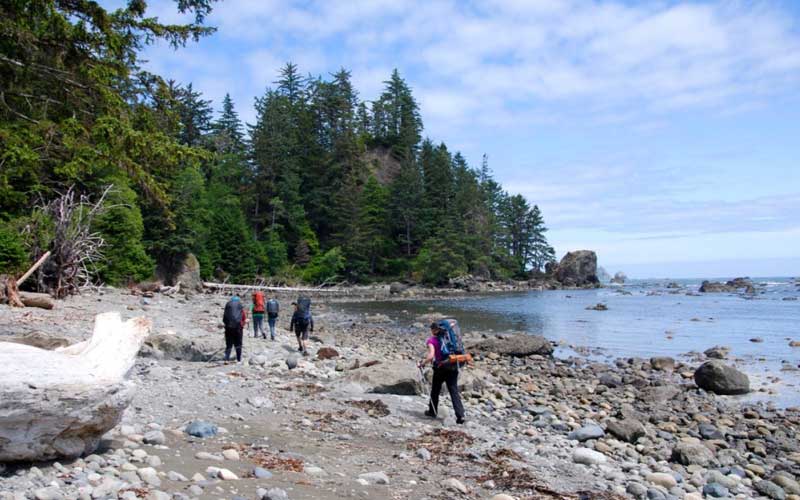
This 9-mile trail offers a superb introduction to the coastal region of Olympic National Park. Even though this is a loop hike, it is called a triangle because of its three prominent legs: The North Sand Point Trail and the Cape Alava Trail. Both of these trails originate at Ozette Campground and reaches the coast at points almost three miles apart. The coastline between the two trails connects them and makes a triangle.
The route chosen by many starts at Cape Alava Trail returning to the North Sand Point Trail. The reason is that, on your way back, the dominant northern winds are at your back pushing you forward as you walk south down the coast. Ozette Triangle then becomes two hikes: one a forest stroll and second, a walk on the beach. You can take the Cape Alava Trail out to the beach and back for a 6.2-mile trip or continue south along the beach to the Sand Point Trail for a 9.4-mile loop.
The history of human habitation is rich in Cape Alava and you should keep that in mind as you walk out of Cape Alava. Recent discoveries of human culture date back to 2,000 years. Cape Alava has a long history of being a corridor between Ozette Lake and the coast. Given the protection of this area, you can imagine what the forest and coast were like back then.
3. Hoh Rain Forest
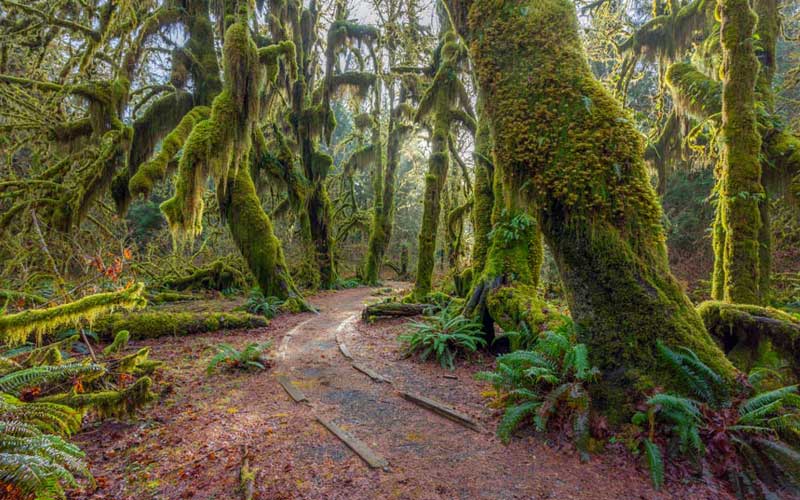
Everyone knows that Amazon is the world’s largest tropical rainforest. However, there are several lesser-known temperate rainforests. One such example is the Hoh Rainforest on the Olympic Peninsula. Rain falls frequently throughout the winter season in the Hoh Rainforest. The Hoh Rainforest gets as much as 14-feet of rain a year. The prevalent fog and mist contribute the equivalent to another 30-inches of rain. The resulting forest is one of the lushest rainforests. It is designated as a wonder of the Washington State.
The Hoh Rainforest is one of the finest remaining examples of temperate rainforest in the United States located in the stretch of the Pacific Northwest rainforest, which once spanned the Pacific coast from southeastern Alaska to the central coast of California. It is one of the most popular destinations in Olympic National Park. It lies on the west side of Olympic National park, about an hour drive from Port Angeles and under an hour from Forks. You can access it by the Upper Hoh Road, off of Highway 101.
The Hoh Rainforest Visitor Center is a great place to start. It is located at the end of the Upper Hoh Road. The staff can give you some ideas there. There are a lot of options from the visitors center like the Hall of Mosses Trail, Sitka Nature Trail. From one mile Hall of Mosses Trail to a full day along the Hoh River Trail, it’s up to you.
4. Marymere Falls
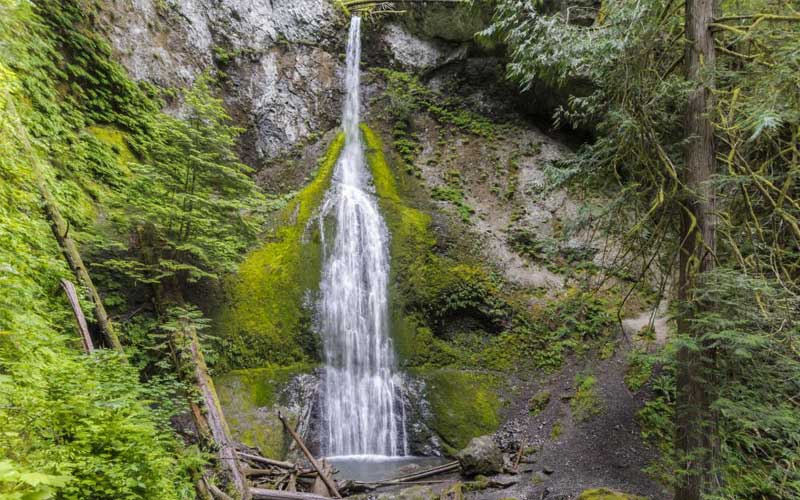
Marymere Falls is located in Olympic National Park near Lake Crescent. A short, well-maintained dirt trail leads to the falls. The trail passes through an old-growth lowland forest consisting of fir, cedar, hemlock, and alder trees. Due to ease of access and being in the proximity of Highway 101, this is a popular spot.
The trip to the Marymere Falls can easily be done in an hour and a half. You can also make occasional stops for photo opportunities and some wild gandering. It is best to go in the afternoon after a nice sprinkle when you can enjoy the pleasant smell of petrichor.
The hike starts near the shores of Lake Crescent from the Storm King Ranger Station. You then enter the moss-laden forest amongst the giant evergreens, cross above two creeks, and ascend up a set of natural stairs for the ultimate view of the Marymere Falls. It is a short and easily accessible loop of only 1.8-miles.
5. Mount Ellinor
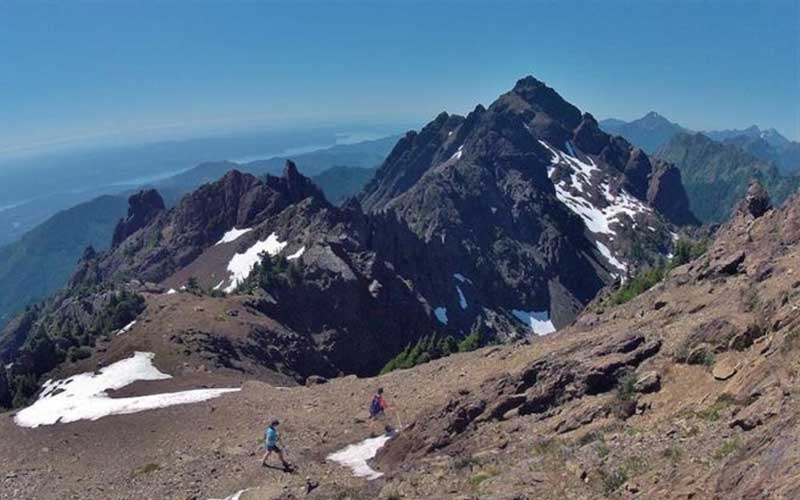
Mount Ellinor is situated in the Olympic Mountains of Washington. The area it is located in is designated as the Mount Skokomish Wilderness and it is a popular day-hike in the summer months.
Mount Ellinor Tail is a heavily trafficked out and back trail located near Hoodsport, Washington. It features a river and is rated as difficult. The trail offers opportunities for a number of activities and is best used from March till November.
Mount Ellinor also gives you two trailheads to choose from. There is a 3.2-mile hike that offers unbeatable views of the Olympics and you will find mountain goats almost everywhere. You can make it a longer 7.2-mile hike if you choose to start at the lower trailhead.
Hikers who reach the summit of Mount Ellinor are treated with a view of Olympic National Park that is rare, more immersive, dynamic and rugged that what you will find on the Hurricane Ridge. Ellinor’s profile is most familiar in Seattle as it’s the southernmost mountain of the Olympics visible from the city.
6. Sol Duc Falls
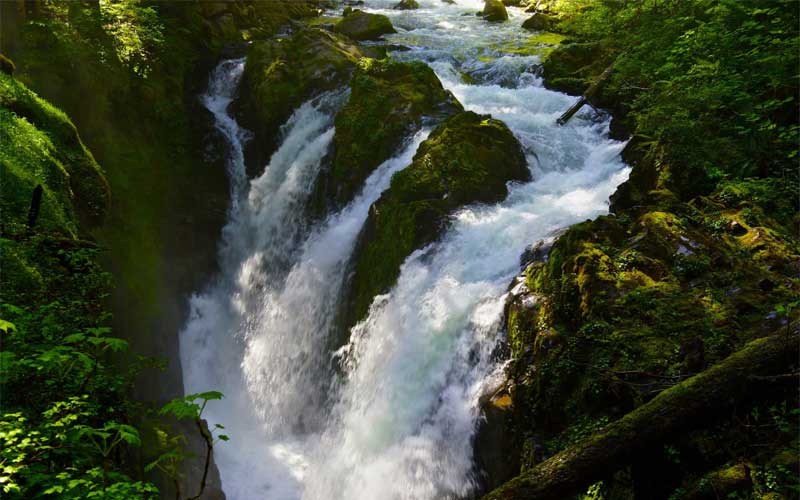
Sol Duc is accessed by turning off Highway 101 onto the Sol Duc Road just 40 minutes west to Port Angeles. The Sol Duc Valley is located in the northwest region of the park. Subalpine lake, old-growth forest, and snowy peaks populate the Sol Duc landscape while the Sol Duc River serves as the key highway for coho salmon running through the valley.
Sol Duc Falls is called the most beautiful falls in Olympic National Park. It is just a few miles from Sol Duc Hot Springs Resort and Campground. Sol Duc Falls is treasure year-round. Unlike other falls on the Peninsula, you view it from above on the brink as it falls 50-feet into the slot canyon below.
The hike to the falls is a short and easy one. From the trailhead, the walk through an old-growth forest to the falls is just under a mile. It is mostly a level trailhead with boardwalks and handrail fence making it suitable for hikers of all levels.
7. Rialto Beach
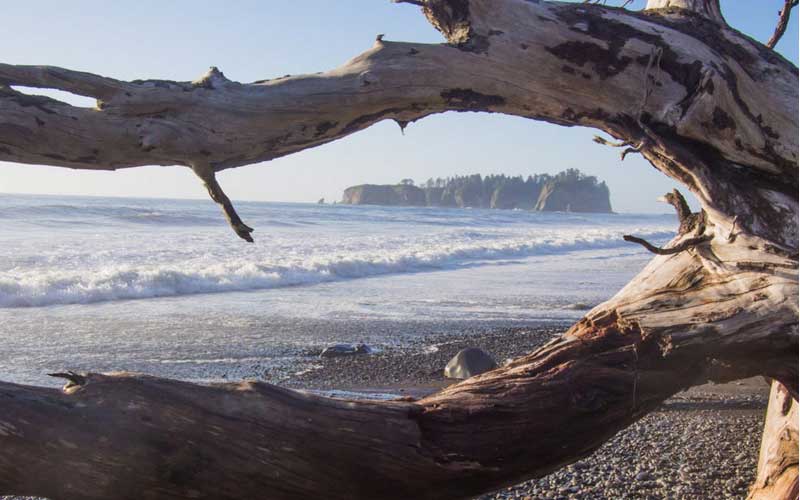
Rialto Beach is a public beach located on the Pacific Ocean in Washington state. It is adjacent to Mora Campground in Olympic National Park near the mouth of the Quillayute River. It is composed of an ocean beach and a coastal forest.
At Rialto Beach, you can stroll along the beach, or in high tide, there is a walkway above the rocks that go to the end of the beach. Giant drift logs, pounding waves, and views of offshore known as ‘setbacks’ are the defining features of Rialto Beach. There is a wonderful view of the Quillayute River opposite to the beach. There are also several picnic benches and restrooms in the car park.
Rialto Beach Trail is a 13.4-mile heavily trafficked out and back trail located near Forks, Washington. The trail features beautiful wildflowers. It is rated as moderate. Rialto Beach is accessible by Mora Road off of La Push Road. The beach is about 36-miles southwest of Lake Crescent and about 75-miles from Port Angeles.
8. Klahhane Ridge
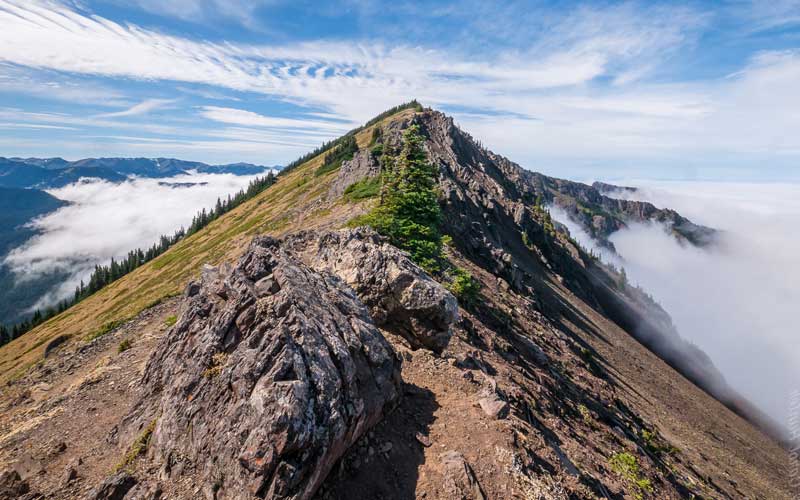
Klahhane Ridge runs west-east between the east face of Mount Angeles and Rocky Peaks. The Klahhane Ridge Trail transverses high, exposed ridges and slopes that extend from Hurricane Ridge to the top of the Klahhane Ridge, which form the headwall over Lake Angeles.
The Klahhane Ridge can be accessed from three routes. The 1.6-mile long Switchback Trail is the steepest and most time-saving trail to the Ridge. The second option is the 3.8-mile trek from the Visitor Center via Sunrise Ridge. The third option is to ascend from Lake Angeles or Heather Park. Both trails start from the same trailhead parking lot.
In the summer, meadows full of colorful wildflowers including Indian paintbrush, lupine, phlox, glacier lilies, line the trail. Wildlife is also frequently seen in the area. You should keep an eye out for mountain goats, marmots, black bears, and deer. The views from the trail extend across the Morse Creek Valley to Hurricane Ridge.
9. Lena Lake
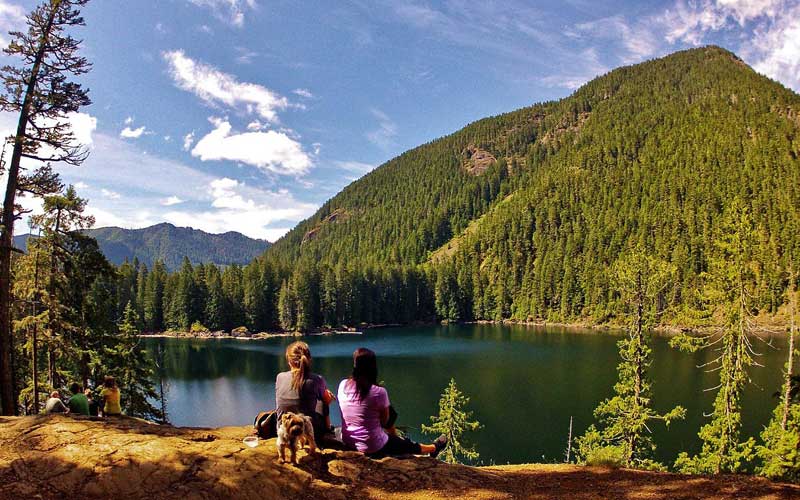
Lena Lake formed 1,300 years ago when a landslide blocked Lena Creek. The creek still flows in the north end of the lake and out of the south end via an underground channel. The moving water keeps the temperature low and so the water is chilly. Although kids and dogs still might enjoy the experience, the water in the Lena Lake is cold nevertheless.
The hike to the Lena Lake can be done by almost every type of hiker. At first, you will go through a wide path with gentle switchbacks followed by a little steep through old and second-growth forest to a large lake surrounded by huge old-growth fir trees.
There are several switchbacks which make it a moderate climb. The trail is very well kept and it is beautiful. It is a very popular trail so expect company. You would need a recreation path to park at the trailhead.
10. Ruby Beach
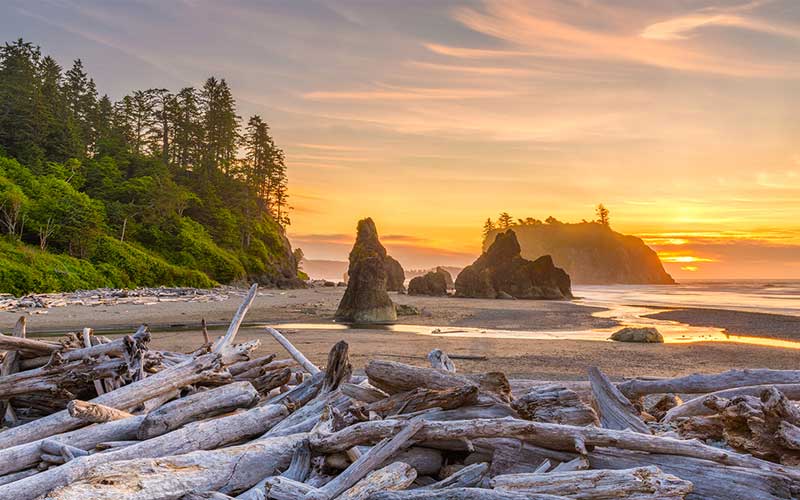
Nobody thinks of the Washington State as a beach destination, but that doesn’t mean Washington doesn’t have the most beautiful beaches around. There are other ways to make up for beauty if the beach is missing palm trees. Ruby Beach is one such beach and is surely the most beautiful beach in Olympic National Park.
Ruby Beach is famous for the reddish sand that occasionally gathers and large, rock islands, the sea stacks. It is the most anticipated beach to visit along the Olympic coastline. You will need to wear something on your feet because Ruby Beach is a rocky beach and not a sandy beach. Flip-flops are recommended.
The 1.4-mile trail to the Ruby Beach is heavily trafficked located near Forks, Washington that features beautiful wildflowers and is good for all skill levels. The trail provides opportunities for a number of activities and is accessible year-round. Dogs are allowed on the trail but must be kept on a leash.

